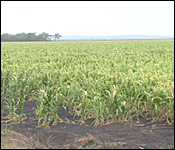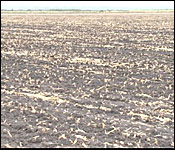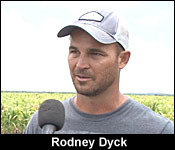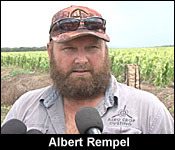
 Last night, we told you how the extended drought in the northern districts has devastated the corn farmers of Blue Creek Village in Orange Walk.
Last night, we told you how the extended drought in the northern districts has devastated the corn farmers of Blue Creek Village in Orange Walk.
Well today, we got to see the extent and cost of the damage to this year's corn crop first hand. Daniel Ortiz has that story:
Rodney Dyck - Grain Farmer, Blue Creek Village
"It's supposed to be twice this size, 3 times this size for sure. At this stage, you'd call it the stage to make tamalitos. But, there's nothing left."
Reporter
"So, nothing is there."
Reporter
"So no tamalitos?"
 Rodney Dyck
Rodney Dyck
"No."
Daniel Ortiz reporting
As you heard Rodney Dyck said, this ear of corn's growth is severely stunted even though the crop from which it was pulled is close to its mature state.
These hundreds of acres cornfields you see cleared here in Blue Creek Village should have been left for a little bit longer before the big harvest. Unfortunately, the severe drought that's been hitting the north has caused over 1200 acres of corn to go bad. If they were left to become fully mature, the plants wouldn't produce the high-quality corn that it normally does when the rains are bountiful. Because the wet season never actually arrived in the north, hundreds of thousands of dollars have gone to waste.
 Albert Rempel - Grain Farmer, Blue Creek Village
Albert Rempel - Grain Farmer, Blue Creek Village
"Usually the rain starts coming in late May, and that's when crops get planted. And so, we actually did get rain about that time, which triggered the farmers to of course start putting the crops out there. So, we planted, and then, it just stopped raining. That was about it. There was sufficient moisture for the crop to actually sprout and come up, as you see behind me. That did work. It did come up, but then, it just didn't rain enough to keep the crop growing to where it could produce harvestable ears on the corn."
Rodney Dyck - Grain Farmer, Blue Creek Village
"For the last 3 months, we haven't been getting the rains that we need. And the corn has just started - it started to grow really nice because we got to plant into moisture. We had about 2 inches of rain. And so, the farmers all figured, okay, the rainy season has started. Let's start to plant. And we stopped having rain, right after planting, and we only got about half of our acres planted. Usually, we run 500 acres of corn, and this year, we only have 280 acres planted. We would have liked to plant everything, but we were lucky that the rains stopped completely, that we didn't fill the farm with corn, because we'd be further in debt, because of that. Now we only have 280 acres that's dying on us right now."
So, to try and salvage some of the value out of this crop, the farmers are harvesting it early to turn into hay for sale to the cattle ranchers.
Albert Rempel
"There comes a time in the cycle of the plant that you just see that it won't be able to fulfill, even if the rain comes. That time has passed. Like it won't be able to actually produce the crop that's supposed to. Basically, it's just a gut feeling that you just see that that won't happen, and so, we might as well salvage. And we just cut it and feed it to the cows, because it does have nutritional value in the stalk itself. But, that doesn't pay for the expenses that have been put in."
"Between me and my brothers, we planted 180 acres at this point. There was a different crop, soybeans, that we were gonna put in later. But, we had planted 180 acres that have all been cut for cattle feed at this point."
Rodney Dyck
"We started moving the machines on Monday. We started mowing the far side, and then yesterday, we got a little drizzle. So, we stopped because once you get a drizzle on mowed hay, it starts to rot. And so, we're just gonna wait until the sun comes out, and we'll chop all the rest. So, 200 and - the full farm is gonna be chopped and fed to cattle, just to salvage the little bit that you can."
So, because this year's corn crop was heavily hit by the drought, the farmers aren't willing to risk planting soybeans. That's would have been the second crop for the year that would have been cultivated in these fields. But, because the drought has been extended, that Soybean opportunity is most likely also lost.
Albert Rempel
"Soybeans are normally planted a little bit later in the year than corn, due to the length of the days, and when we harvest at the end of the year. Soybeans, the mark where plant soybeans are normally in July, the middle towards end. And that's past a month now. So, for us to put in a soybean crop yet, the days are numbered. So, likely, we will lose all that revenue as well."
And for the Blue Creek farmers, the financial losses as a collective are staggering.
Albert Rempel
"I'm not sure. It's at $252,000 that we would have expected to get in return."
Rodney Dyck
"What you see behind me is the corn that's been planted. I already have about a $125,000 invested in that corn. And I'll maybe get - maybe - $30,000 from that. And then, I have all the rest of the acres that are supposed to be planted in June and July, and the longer I wait, the less of a chance I have to get a good yield on the rest of the acres."
 Peter Dyck - Manager, Northern Grains Cooperative
Peter Dyck - Manager, Northern Grains Cooperative
"On soy beans, well, they're still hoping for rain. They're hoping to plant yet. But if they can't plant, if the rains don't come soon, there will be about a 2.3 million-dollar revenue lost on soy beans alone. On corn, the way it looks right now, it will probably be about 2.5 million-dollar revenue loss."
Rodney Dyck
"The inputs, most of it comes from loans through banks, and that's how we finance with, normal interest rates."
But, even though their way of life is putting them through financial hell, for these farmers, it's a labor of - currently unrequited - love.
Albert Rempel
"So far, that's always just how it's been. You just hope for a better year. You hope that the rains will be better next year. So, you put in another crop to try and recover, and it has happened. Luckily, for us farmers out here, it has happened. We've had losses before, and then all of a sudden, we'll have a year where prices are good, markets are good, and inputs have been reasonable, and so, yields are good. But, those come around once every 10 years maybe. So, we're forced to stay afloat with other sources of inputs, like - as you know - a lot of the farmers out here they don't have just a grain farm. Some of them also have a cattle ranch. So, they balance each other out once in a while. But now, this drought has been so extensive that even the cattle farms are suffering because there's not enough water to even sustain the cattle from the grass they're able to feed on."
Reporter
"For those of us who aren't farmers, who don't love the land the way you do, it seems like you are fighting an uphill battle. Why would you continue to do this to yourselves annually?"
Rodney Dyck
"You know, I ask myself that every year, and I really enjoy the work. I love to farm. And that's one part. That's one part of it. I have to look around because I know the farm it's just sinking and sinking. It's very very difficult in Belize to be a farmer. In the world, when you talk farmers, farmers know it's difficult."



